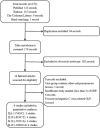Association between polymorphisms in interleukins and oral lichen planus: A meta-analysis
- PMID: 28296743
- PMCID: PMC5369898
- DOI: 10.1097/MD.0000000000006314
Association between polymorphisms in interleukins and oral lichen planus: A meta-analysis
Abstract
Background: More and more studies have suggested that single-nucleotide polymorphisms (SNPs) in interleukin (IL) genes are correlated with an increased risk of developing oral lichen planus (OLP). However, these results were inconsistent. Therefore, the aim of this meta-analysis is to retrieve and comprehensively analyze all related clinical studies to investigate the association of ILs gene polymorphisms with the OLP risk.
Methods: PubMed, Embase, and the Cochrane Library were searched for eligible studies to evaluate the association between IL polymorphisms and the OLP. The odds ratios (ORs) and 95% confidence intervals (CIs) from each study were pooled to estimate the strength of the association. Statistical analyses were performed by using STATA software.
Results: In all 6 studies, including 4 SNPs (IL6-174G/C, IL10-592C/A, IL10-819C/T, and IL10-1082G/A), 362 OLP patients and 622 non-OLP control subjects from five different countries were investigated. As for the IL6-174G/C, IL10-819C/T, and IL10-1082G/A, no evidence was found to support the association between SNP and OLP susceptibility in any genetic models. However, as for IL10-592C/A, a significant relationship between them was identified in all of comparison models (C vs A: OR = 0.724, 95% CI = 0.585-0.897, P = 0.003; CC vs AA: OR = 0.447, 95% CI = 0.276-0.722, P = 0.001; AC vs AA: OR = 0.585, 95% CI = 0.387-0.883, P = 0.011; CC+AC vs AA: OR = 0.544, 95% CI = 0.365-0.809, P = 0.003; CC vs AA+AC: OR = 0.715, 95% CI = 0.515-0.994, P = 0.046).
Conclusion: With the presently available evidence, this meta-analysis fails to show the statistical associations between IL6-174G/C, IL10-819C/T, and IL10-1082G/A and OLP susceptibility in any genetic models. However, the A allele and AA genotype in IL10-592C/A polymorphism may increase the risk of OLP. In the future, more well-designed studies with larger sample sizes are needed.
Conflict of interest statement
The authors have no conflicts of interest to disclose.
Figures





Similar articles
-
TNF-α, TNF-β and IL-10 gene polymorphism and association with oral lichen planus risk in Saudi patients.J Appl Oral Sci. 2015 May-Jun;23(3):295-301. doi: 10.1590/1678-775720150075. J Appl Oral Sci. 2015. PMID: 26221924 Free PMC article.
-
IL-10 gene polymorphisms and susceptibility to systemic lupus erythematosus: a meta-analysis.PLoS One. 2013 Jul 23;8(7):e69547. doi: 10.1371/journal.pone.0069547. Print 2013. PLoS One. 2013. PMID: 23936042 Free PMC article.
-
Association of genetic polymorphisms in interferon-γ, interleukin-6 and transforming growth factor-β1 gene with oral lichen planus susceptibility.BMC Oral Health. 2016 Aug 20;16(1):76. doi: 10.1186/s12903-016-0277-x. BMC Oral Health. 2016. PMID: 27544215 Free PMC article.
-
Association Between the Interleukin-10-1082G/A, -592C/A, -819C/T Gene Polymorphism and HIV-1 Susceptibility: A Meta-Analysis.AIDS Res Hum Retroviruses. 2017 Jan;33(1):61-67. doi: 10.1089/AID.2016.0056. Epub 2016 Nov 28. AIDS Res Hum Retroviruses. 2017. PMID: 27785918 Review.
-
Association of IL-6, IL-10 and TGF-β1 gene polymorphisms with brucellosis: A systematic review with meta-analysis.Microb Pathog. 2019 Oct;135:103640. doi: 10.1016/j.micpath.2019.103640. Epub 2019 Jul 22. Microb Pathog. 2019. PMID: 31344477
Cited by
-
Oral Lichen Planus: An Updated Review of Etiopathogenesis, Clinical Presentation, and Management.Indian Dermatol Online J. 2023 Dec 22;15(1):8-23. doi: 10.4103/idoj.idoj_652_22. eCollection 2024 Jan-Feb. Indian Dermatol Online J. 2023. PMID: 38283029 Free PMC article. Review.
-
Dental Implants in Patients with Oral Lichen Planus: A Systematic Review.Medicina (Kaunas). 2020 Jan 27;56(2):53. doi: 10.3390/medicina56020053. Medicina (Kaunas). 2020. PMID: 32012782 Free PMC article.
-
Oral and non-oral lichen planus show genetic heterogeneity and differential risk for autoimmune disease and oral cancer.Am J Hum Genet. 2024 Jun 6;111(6):1047-1060. doi: 10.1016/j.ajhg.2024.04.020. Epub 2024 May 21. Am J Hum Genet. 2024. PMID: 38776927 Free PMC article.
-
Development of an immune-related diagnostic predictive model for oral lichen planus.Medicine (Baltimore). 2024 Mar 15;103(11):e37469. doi: 10.1097/MD.0000000000037469. Medicine (Baltimore). 2024. PMID: 38489725 Free PMC article.
-
[Gene polymorphism in oral lichen planus].Hua Xi Kou Qiang Yi Xue Za Zhi. 2020 Dec 1;38(6):681-686. doi: 10.7518/hxkq.2020.06.013. Hua Xi Kou Qiang Yi Xue Za Zhi. 2020. PMID: 33377347 Free PMC article. Chinese.
References
-
- McCartan BE, Healy CM. The reported prevalence of oral lichen planus: a review and critique. J Oral Pathol Med 2008;37:447–53. - PubMed
-
- Belfiore P, Di Fede O, Cabibi D, et al. Prevalence of vulval lichen planus in a cohort of women with oral lichen planus: an interdisciplinary study. Brit J Dermatol 2006;155:994–8. - PubMed
-
- Roopashree MR, Gondhalekar RV, Shashikanth MC, et al. Pathogenesis of oral lichen planus—a review. J Oral Pathol Med 2010;39:729–34. - PubMed
-
- Eisen D. The clinical features, malignant potential, and systemic associations of oral lichen planus: a study of 723 patients. J Am Acad Dermatol 2002;46:207–14. - PubMed
-
- Lozada-Nur F, Miranda C. Oral lichen planus: epidemiology, clinical characteristics, and associated diseases. Semin Cutan Med Surg 1997;16:273–7. - PubMed
Publication types
MeSH terms
Substances
LinkOut - more resources
Full Text Sources
Other Literature Sources
Molecular Biology Databases
Research Materials

